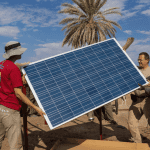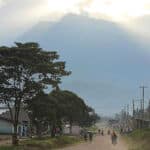Who Should Get COVID-19 Funding? How MIT D-Lab’s ‘Urgency Index’ is Helping it Deploy Grants to the Entrepreneurs Who Need Them Most
When I called Peter Mumo Nyamai in late February to discuss the looming COVID-19 crisis, he was not impressed. “The pandemic?” he asked incredulously. “We are most worried about the locust invasion ravaging our fields!” Nyamai is a soft-spoken 32-year-old Kenyan, founder of Expressions Global Group, and a current MIT D-Lab Scale-Ups fellow. He used to work for an agrochemical company in Nairobi before he struck out on his own to start a venture providing piped irrigation, training and market access to small scale-farmers in Makueni county in Eastern Kenya.
Out of the frying pan, into the fire
Nyamai took my call from the field, while working at the front lines to combat the worst locust invasion that the country has seen in 70 years. By the end of 2020, the massive locust swarms are expected to cause over $8.5 billion in damage and threaten millions of East Africans with starvation. So it was understandable that the crisis would be top-of-mind for the region’s farmers and the organizations that serve them.
But by mid-March, Kenya was under a COVID lockdown, and my conversations with Nyamai took an increasingly urgent tone. Across the country, schools, institutions and restaurants were closed and no longer in need of fresh fruit and vegetables. His distribution network of local buyers was in complete disarray due to the restriction of movement between counties and the nationwide dusk-to-dawn curfew. Demand for produce was at an all-time low, and as a result, the subsistence farmers he supported were losing income fast. His team, usually active in the field, was now working from home, straining to respond quickly to the ever-changing situation using the Whatsapp and text message channels they had at hand. Additionally, funding opportunities were drying up at the very moment that Nyamai’s business needed cash the most. “And the locusts?” I asked. “The swarms are growing and they are hungry,” he replied.
The Three Main Challenges for D-Lab Businesses During COVID-19
Before COVID-19, Expressions Global Group was steadily growing – and so was its impact in the field. Because of its work, 250 farmers and their families reported efficient water usage, higher yields, better market access and fairer pricing for their agricultural products. But with markets seizing up due to the pandemic, the company’s trajectory has been derailed and its future is unclear. And a quick pulse check on our portfolio at MIT D-Lab revealed that Expressions Global Group’s experience is far from unique.
We collected data on 19 ventures to ramp-up our understanding of how these businesses have been impacted. This is a snapshot of what we found, based on data from March and April:
- Business disruption: The most common issues were disrupted distribution and point-of-sale activity (reported by 68% of ventures each), followed by supplier disruptions (63%) and manufacturing and production process disruptions (43%). For 90% of entrepreneurs, two or more of these problems were present at the same time.
- Customer loss: On average, entrepreneurs lost (or were unable to serve) 64% of their customers during the month of March, with two-fifths of the 19 enterprises reporting a staggering 75% loss of their customer base. In total, the business-to-customer companies we surveyed reported losing more than 33,000 customers, and our business-to-business companies could no longer serve 41 of their previous clients at the time we conducted our survey. We also observed that business-to-business companies (which experienced a loss of around 78% of customers) were affected more than business-to-customer companies (which lost around 59% of customers).
- Liquidity crisis: In March, 68% of the entrepreneurs registered net losses due to severe business disruption and customer loss. Additionally, many found that they were ill-equipped to handle the crisis: 53% had less than one month of cash runway in the bank.
It is evident that the type of enterprises that D-Lab supports through its Scale-Ups program – the early-stage, inclusive, local, high-impact organizations that aim to deliver scalable solutions in low-income markets – are deeply struggling. Their ability to continue to serve marginalized communities and support livelihoods has been disrupted, and many people stand to lose if these pioneering ventures collapse.
COVID-19 Urgency Index – Behind the scenes of the MIT D-Lab Bridge fund model
What do you do when the stakes are high, time is ticking and resources are scarce? We knew that funding was the single biggest short-term need these businesses had, so we quickly decided to deliver some form of capital infusion to keep our companies on track. We decided to create a COVID-19 Bridge Fund and we reached out to MIT D-Lab’s existing program donors to ask for help. We found three who eagerly agreed to support our new initiative. With U.S. $105,000 in hand, which we raised in less than a month, we started to develop a COVID-19 Urgency Index that would be fair, rigorous and effective in directing funding to where it would make the most difference.
We know our founders well, so our due diligence process focused on collecting real-time data on the immediate challenges that they were facing. We organized the data we collected along three critical dimensions that aligned with the mission and vision of MIT D-Lab:
- Impact Erosion: What is the real-life impact the company is having on the livelihoods of customers and employees?
- Business Vulnerability: How affected is the business now and how exposed will it be in the future to COVID-19 risk?
- Future Growth Capability: What is the potential that the venture will survive and thrive after the pandemic?

We broke down these three dimensions further into seven discrete and additive index factors, each of which added U.S. $1,000 to the overall sum awarded, thus creating a funding model directly responsive to the intensity of need. Of the seven index factors, six are based on objective quantitative data (see image above). Only the “potential for growth” criteria is qualitative. We incorporated it to give our leadership team an opportunity to weigh in and assess the applicant’s growth capabilities. We received 19 applications and we decided that every Scale-Ups program fellow who applied for support would be eligible for a minimum grant of U.S. $1,000. The maximum grant amount the Urgency Index would allocate was U.S. $8,000.
How did it work in practice? We provided 19 COVID-19 Bridge grants in under a month, and the average size of the grant that a MIT D-Lab-supported entrepreneur received was U.S. $5,500. Among these fellows, 68% are working in Africa, 21% in India, and 11% in other geographies. The most common sector among applicants was agriculture (21% of applicants), followed by energy, health and livelihoods (16% each). Additionally, 73% of our recipients were local entrepreneurs and 43% were women founders.
Our COVID-19 Urgency Index helped us shed light on the disparities of need among these enterprises, and also helped pinpoint discrete challenges that we could try to address through our programming. Below, we share two illustrative examples.

This Scale-Ups agriculture venture was facing complex business obstacles, its supply chain had ground to a halt and it was unable to serve its beneficiaries. Our team granted it a maximum grant of $8,000, agreeing that despite these hurdles, it had the potential to recapture the promising growth trajectory it was on before the onset of the pandemic.

This healthcare finance venture, on the other hand, was still early-stage, it was still working on product-market fit and it demonstrated a stronger financial position that would allow it to continue to work and pay its team in the near term. It was awarded a smaller sum through the Bridge fund model.
An experiment in endurance
By providing catalytic capital and a safety net during tough times, the Bridge grants aim to help founders figure out how to get to their next stage of growth. More specifically, we hope this financing will create conditions that will:
- Save jobs: Together, the applicants employ 439 people, an average of 23 at each business. We hope to support employee retention, so the entrepreneurs do not have to rebuild their teams from scratch after the crisis.
- Increase cash runway: Through the Bridge grants, we have increased the runway of 53% of entrepreneurs by an average of 1.5 months. The funding is flexible, and it can be used where it is most needed.
- Enable businesses to experiment and adapt: 75% of our fellows were in the process of raising additional money. We hope the bridge grants buy them some time to make necessary changes or pivots to their existing offerings.
Entrepreneurs today face the Sisyphean task of pulling their ventures out of an unprecedented crisis. COVID-19 is making them smaller and scrappier – and the pandemic is far from over. As cases in some Western hemisphere countries begin to abate, COVID-19 transmission is growing at an alarming rate in densely populated, low-income countries across Africa, Latin America and South Asia. Many of our entrepreneurs (and the communities they serve) may be at the next epicenters of the pandemic, and they lack government safety nets to prop them up.
The MIT D-Lab Bridge fund is a small-scale experiment on how to build endurance in these markets. It is a cup of water, strategically offered, during a long marathon. As a one-time grant, prioritizing immediate liquidity and flexibility, this support aims to extend the runway for businesses in dire straits – but more help is needed.
As organizations like MIT D-Lab explore how to offer that support, we need to keep in mind that local founders and female founders are most at risk, irrespective of how their businesses are faring. The contraction of funding opportunities may exacerbate pre-existing, deeply entrenched inequities in how capital is parceled out. Funding is an opportunity to unlock opportunity and access, and the development sector must do better to support the most vulnerable entrepreneurs whose demographics may not fit the pattern that many investors are looking for. At D-Lab, we are actively pursuing opportunities to expand just and equitable support to underserved entrepreneurs. Since, 2019, D-Lab Scale-Ups has been committed to exclusively working with local founders. Next year, we will turn our focus more deeply to gender, and we will pilot our first all-female cohort.
And Peter Mumo Nyamai? His business is still slow, but half of his team is supporting an international NGO that was looking for temporary employees to meet increased demand to combat the locust invasion. “This gives us some breathing room,” he says, “but we are eager to get back to our irrigation work.” He remains focused on a future that’s likely to be permanently changed by the pandemic: “The Bridge fund money will help us set up six clean water stations in the community,” he says. “Drinking water and clean hands are extremely important right now.”
NOTE: MIT D-Lab’s Manual to Land (draft) was developed with the broader lens of helping entrepreneurs in emerging markets to better navigate crisis leadership while focussing on their finances, their team or the customer side.
Jona Repishti is Social Entrepreneurship Manager at MIT D-Lab. Sagar Tandon is founding member of Moonshot Ventures and is serving as a Venture Affiliate for MIT D-Lab Scale-Up fellows.
Photo: Peter Mumo Nyamai (far right) – courtesy of MIT D-Lab.
Homepage photo courtesy of Climate Change, Agriculture and Food Security.
- Categories
- Coronavirus, Investing



